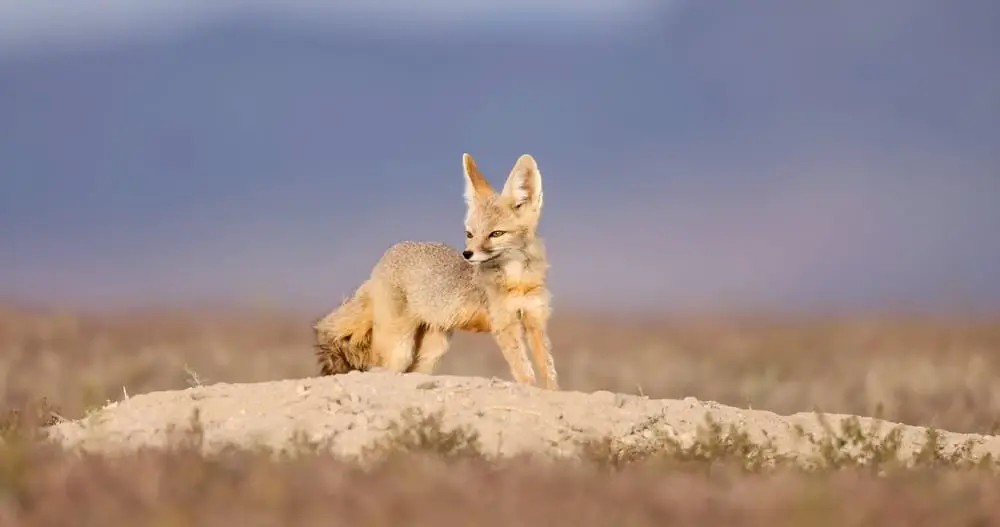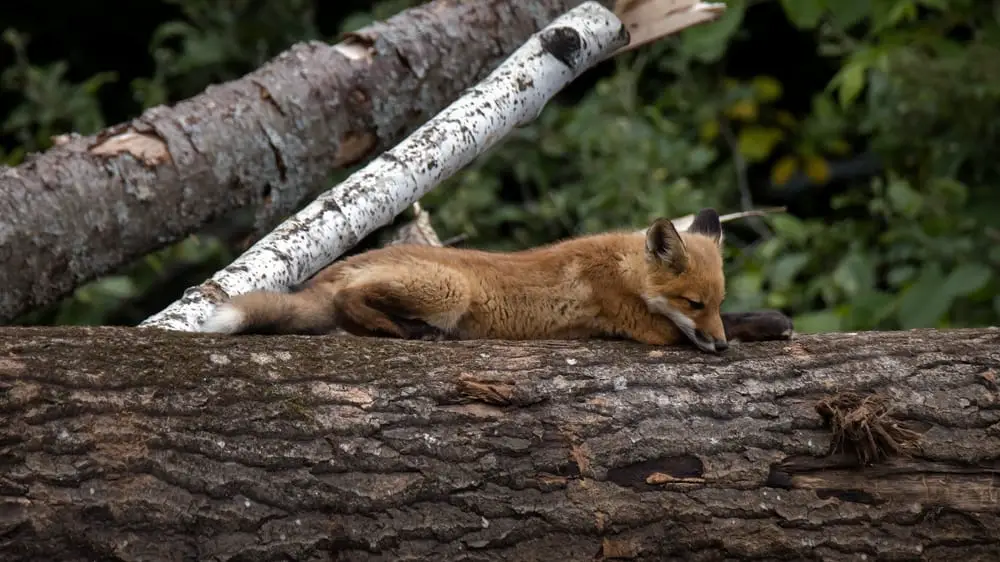The kit fox (Vulpes macrotis) is an iconic species of the North American deserts, living in a variety of habitats from southwestern Canada to northern Mexico. It is one of the smallest members of the canine family and inhabits arid regions such as sagebrush steppe, grasslands, saltbush scrub, pinyon-juniper woodland and desert riparian zones.
As a result of this wide range, it has become adapted to survive extreme temperatures, ranging from -30°C to +45°C throughout its range.
Kit foxes are primarily nocturnal animals that feed on small rodents like mice and voles but also consume insects, carrion, plant material and eggs. They can be distinguished by their long ears, sandy coat with black-tipped guard hairs and slim body structure which aids them in burrowing into dens for protection during cold winter months or when raising young kits.
Reproductive behavior revolves around pair bonding between mates where they remain together while raising offspring until dispersal occurs at 8-10 months old.
This article examines the ecology and life history traits of the kit fox including diet composition, habitat selection, reproductive behavior and distribution across its vast geographic range.
By understanding these components we gain further insight into how this species survives the changing climate conditions within their native environment over time; allowing us to better inform conservation efforts specifically targeting V. macrotis populations worldwide.

Species Overview
The kit fox (Vulpes macrotis) is a species of the Canidae family that has adapted to many environments. This small canid is native to North America and typically found in arid climates, such as deserts and steppes. It is one of the smallest members of its genus, with an average body length between 41-50 cm at full maturity.
Its fur color varies from golden yellow to grayish brown depending on the environment where it resides. The kit fox’s coat tends to be more pale during summer months and darker during wintertime for protection against colder temperatures.
Kit foxes have large ears which help them detect prey easier, while also regulating their body temperature by releasing heat when necessary. They are nocturnal hunters, preying upon rodents, rabbits and other small mammals as well as certain birds and reptiles. Their habitats range from grasslands to sparsely vegetated areas near rivers or streams.
Habitat And Distribution
The kit fox (Vulpes macrotis) is a small canid species distributed throughout the southwestern United States and northern Mexico. Its preferred habitat ranges from low-elevation desert scrublands to high-altitude grasslands, but its range has been reduced by habitat loss and fragmentation.
Kit foxes require an abundance of cover for denning, such as creosote shrubs, yucca plants, or abandoned burrows of other animals. They prefer habitats with little human disturbance, where they will feed on rabbits and rodents during nocturnal hunts.
In terms of distribution, kit fox populations are now concentrated in California’s Central Valley and southern Great Basin regions, plus Utah’s Wasatch Range area; however there may be small pockets elsewhere due to dispersal events occurring after the initial population decline. The following areas provide suitable habitat requirements for kit foxes:
- Semiarid deserts
- Shortgrass prairies
- Badland formations
- Riparian corridors
Diet And Hunting Behavior
Kit foxes are opportunistic predators and scavengers, primarily consuming small mammals such as rodents, rabbits, ground squirrels, kangaroo rats, voles, and birds. Additionally, they will also feed on plant matter like fruits and berries when available.
They vary their diet based upon availability of resources in the environment. Kit fox hunting behavior is typically nocturnal because many of their prey items are active at night; however, they can be seen during daylight hours searching for food or resting in dens.
When hunting for small mammals kitfoxes use a combination of stalking techniques with short sprints to capture their prey. During these hunts, kit foxes rely heavily on their hearing due to poor eyesight as well as thick vegetation that may obscure visibility. If unsuccessful in catching live prey then they will supplement their diet by scavenging carcasses left behind by other animals such as coyotes or badgers.
In addition to being an important predator within its habitat the kitfox plays a critical role in balancing the local ecosystem through its predation and scavenging activities. By doing so it helps maintain healthy populations of smaller mammal species throughout its range which supports biodiversity and overall ecological health.
Reproduction And Lifespan
The kit fox is a solitary species, with mating and breeding typically taking place during the winter months. Mating activity peaks in February and March, with most pups being born between April and June. The gestation period for a kit fox is around 51 days.
Litters usually consist of three to five kits, though larger litters are possible. It takes about two years before the juveniles reach maturity and can begin reproducing.
In terms of lifespan, the average age of wild kit foxes ranges from 6-8 years old; however, individuals have been known to live up to 14 years in captivity.
Most mortality occurs within their first year due to predation or disease but once they make it past that stage their odds of survival increase significantly as adults. Kit foxes living in urban environments tend to show higher longevity than those living in rural areas due to less exposure to predators or human interference.
On an annual basis, adult female kit foxes will produce one litter per calendar year while males may mate multiple times over the course of season. Males will remain with females throughout the pregnancy until after birth when they abandon them along with newborn kits; this behavior is thought be linked more closely to food availability rather than parental care since male kit foxes do not provide any kind of paternal care whatsoever.
Kit fox reproduction has become increasingly important in recent decades due to habitat loss and fragmentation caused by human development which has led some populations into states of decline due to lower genetic diversity among existing members. Conservation efforts are ongoing in order preserve these unique creatures for generations to come.
Conservation Status
The conservation status of the kit fox (Vulpes macrotis) is vulnerable in some parts of its range. It has been listed as an endangered species in California and Utah, and it is classified as a species of special concern under federal law. The main threats to this small canid are habitat loss due to human activities such as urbanization, agriculture, and resource extraction.
Conservation efforts have included targeted land protection measures to protect critical habitat, re-introduction programs into areas where they were previously extirpated, population monitoring, and research aimed at understanding their ecology.
These actions have helped reduce extinction risk for the species; however, additional work needs to be done in order to ensure long-term persistence of kit fox populations.
Continued investment in appropriate conservation strategies will help prevent further declines in species numbers and secure the future of the kit fox. In addition to direct action on behalf of threatened or endangered species, public education campaigns that raise awareness about issues facing wildlife can also contribute significantly to effective conservation outcomes.

Human Interactions
Humans have had a significant impact on the kit fox population and its habitat. Human activities such as farming, agricultural development, urbanization and land management practices can all lead to disturbances of kit fox habitats.
As human populations grow and spread outward from cities into rural areas, they are likely to encroach upon the natural territories that wild animals inhabit for food and shelter. Human interference in these environments may also disrupt feeding behaviors leading to reduced health or death due to starvation.
In addition, humans often hunt various wildlife species including the kit fox which decreases their numbers significantly. Poaching is especially detrimental because it reduces genetic diversity within a species’ population which can cause negative long-term consequences. Moreover, domestic dogs have been known to kill small mammals like the kit fox while out hunting with their owners, further reducing their numbers in certain regions.
Human activities also pose another problem: pollution has been linked to lower survival rates among kit foxes living near oil wells, gas fields and other industrial sites where hazardous materials are common byproducts of production processes.
These pollutants accumulate in soils and groundwater supplies resulting in contaminated drinking water sources which adversely affect the health of nearby wildlife populations over time. In some cases, human activities have caused entire populations of kit foxes to become extinct or nearly extinct due to environmental impacts such as climate change or destruction of their habitats through deforestation or overgrazing of land by livestock herds.
The effects of human influence on this species should not be underestimated; conservation efforts must remain focused on mitigating potential threats posed by humans so that current and future generations may continue enjoying healthy kits fox populations worldwide.
Interesting Facts
The kit fox (Vulpes macrotis) is a highly intelligent and adaptable species of canid found in parts of western North America. It has evolved several unique biological traits that have enabled it to survive in extreme conditions, such as the harsh desert environment.
Kit foxes possess an incredible level of intelligence, which helps them outwit their predators and find food sources. They also use complex vocalizations to communicate with each other in order to coordinate group activities or alert one another of potential danger.
Kit foxes are well-adapted for survival in arid climates; they have thick fur coats that protect them from cold temperatures at night, while their large ears dissipate heat during the day. In addition to these physical adaptations, kit foxes have developed behavioral strategies for dealing with predators such as coyotes and bobcats.
When threatened by larger animals, they will often retreat into burrows or dig shallow holes where they can hide safely until the predator passes by.
The evolution of the kit fox has been shaped by its need to stay hidden from predators and access limited resources within its habitat. Its diet consists mainly of small rodents and insects, but some individuals may supplement this with fruit or carrion when available.
By adapting its behavior according to environmental changes over time, the kit fox has become an incredibly successful species despite having few natural defenses against hungry predators.
This remarkable adaptation has allowed the kit fox to thrive in many different habitats across North America where other canine species would not be able survive due to competition or predation risk. The remarkable intelligence and adaptive nature of this animal make it an intriguing subject for further study on how changing environments affect evolutionary processes among wildlife populations worldwide.
Conclusion
The kit fox (Vulpes macrotis) is one of the smallest members of the Canidae family and a unique species. This small canid has an impressive ability to survive in a variety of habitats, ranging from deserts to prairies, due to its remarkable adaptation skills.
Its diet consists mainly of small mammals such as rodents, hares, ground squirrels and lizards which it hunts by night. Kit foxes typically mate for life and produce two or three litters per year with around four pups each time.
In recent years there have been several threats that put this species at risk, including disease transmission from domestic dogs, destruction of their natural habitat through agricultural activities and urbanization, predation from coyotes and other larger predators, hunting and trapping pressure, road mortality and fragmentation of their suitable range.
To ensure these animals will continue to exist in the wild conservation measures must be taken on both local and global scales so all necessary steps are taken for protecting them.
Overall the kit fox is an iconic species that represents a piece of North American history; however more research needs to be done to understand how we can help keep them safe and successfully living in the wild. Through continued efforts towards preserving this species’ future we hope they will remain part of our natural heritage for many generations to come.

